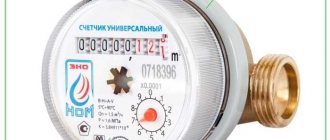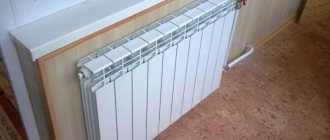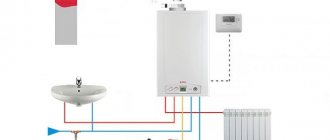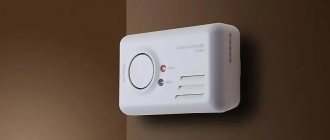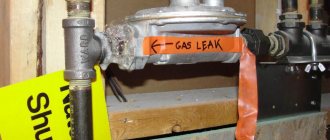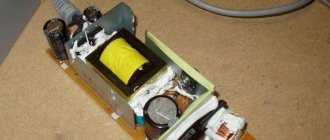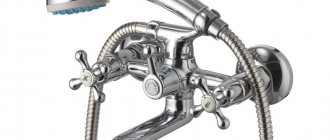Today, gas is the most affordable energy carrier, which is used for heating and water heating and cooking in apartment buildings and private residential buildings. But inexpensive does not mean at all that it can be used in any volume, simply paying some kind of conditional fee, as was previously the case. Control of blue fuel consumption is carried out using special metering devices.
How to choose household gas meters
Federal Law No. 261 of November 23, 2009 “On energy saving and increasing energy efficiency” established that by 2015 (for Crimea and Sevastopol - until 2022), all residential buildings, according to the list given in the document, must be equipped with gas meters. And although there are no penalties for the lack of a device yet, we must assume that they will appear soon. Therefore, it is time for owners of houses or apartments who have not yet acquired this device, or who are planning to replace it with a new one, to think about the problem of choosing the optimal model.
So, how to choose a reliable and most suitable option for specific operating conditions with household gas meters?
Types of gas meters
The device that monitors the consumption of gaseous fuel is called a gas meter. It is built into the gas main through which this energy is supplied to the apartment or house. When monitoring the consumption of blue fuel in a private home, the meter can be installed on the street, in the area adjacent to the house, or directly in one of the suitable premises inside. In high-rise buildings, metering devices are installed in each apartment.
Mechanical multi-digit counting device
Gas flow meters come in a variety of designs, and different principles are used to make ongoing measurements of consumption volume. Three main components remain common - the housing, the measuring mechanism and the counting device.
The principle of accounting for gas passing through the device depends on its type:
- Mechanical meters take into account the various properties of gases, under the influence of which the mechanism for transmitting rotation to the counting device is activated.
- In electronic models, special sensors generate electrical pulses corresponding to a certain volume of gas passed through. The number of these pulses is taken into account and converted into volumetric flow rates.
Meter with digital LCD display for reading.
Indication of readings in meters of different operating principles can be carried out through a multi-digit mechanical counting device or displayed on a digital display.
Types of gas meters by purpose
Gas consumption meters are divided according to different criteria. Thus, appliances can be domestic, municipal and industrial. The main difference in this criterion lies in the throughput of the measuring device.
- For household meters intended for installation in an apartment or private house, a throughput of 1.6 to 6 m³/h is sufficient.
For example, for an apartment in which only a gas stove is installed, a device with a throughput capacity of 1.6 m³/h is ideal. If the owners also use a instantaneous gas water heater, then it is worth considering the option of 2.5 m³/h. And for a private house in which gas is consumed mainly for heating needs, you will need a meter with a throughput capacity of at least 4 m³/h.
- Utility meters have a throughput from 10 to 40 m³/h. They are installed in small autonomous boiler houses, technological installations, etc.
- Industrial models are capable of passing 40 or more cubic meters of gas per hour. The purpose is clear from the name, and, of course, they are not used at the household level.
The throughput indicator is indicated on the front panel of the device. In addition, very often there is a digital index in the name of the model itself, for example, “G4” or, say, “Breeze-1.6”.
The gradation of throughput is adopted as follows: 1.6; 2.0; 4.0; 6.0; 10.0; 16.0; 25.0 and even higher. These are, so to speak, nominal throughput indicators. The maximum capabilities are slightly higher:
| Digital index in the device name | Nominal and maximum capacity of the meter |
| 1.6 | 1,6/2,0 |
| 2 | 2,0/4,0 |
| 4 | 4,0/6,0 |
| 6 | 6,0/10,0 |
| 10 | 10,0/16,0 |
This maximum throughput figure is also indicated on the panel along with other characteristics. Typically, it is denoted by the symbol Qmax .
As mentioned above, in some cases it will be necessary to purchase a meter to install it on the street. In this case, it is necessary to choose a model adapted to such operating conditions.
The fact is that gas flow meters are generally designed for installation in heated rooms, in which a fairly even temperature of about 15÷25 ℃ is maintained year-round. But if such a device is installed outdoors, a very significant error in readings will appear. When it gets colder, gas significantly loses volume, and the supplier loses. And vice versa, with the arrival of the summer heat, due to the expansion of gas from the normal volume, the consumer has to pay more.
Useful information located on the front panel of the gas meter: the rated capacity indicator in the model name (yellow arrow); maximum throughput (green arrow); the letter “T” indicating the presence of a thermal corrector (blue arrow).
Prices for gas meters
gas meter
A large letter “T” is placed next to the digital marking of such a model, for example, “G4T”. This designation provides information that the device is equipped with a thermal corrector (temperature compensator), which at low and high temperatures minimizes the errors in gas meter readings. Such a metering device, of course, has a higher cost, but if you plan to install it on the street, then there is nowhere to go - you will have to purchase just such a one.
Find out which geyser is best to choose in terms of reliability and quality, and also check out the rating in special publications on our portal.
Types of gas meters based on operating principle
There are several types of gas meters with different principles for estimating the volume of energy passing through them, some of them are compact and therefore more suitable for installation in apartments. Others, which are larger in size, are more often installed in private homes, but are also suitable for apartment conditions.
Membrane gas meter
A membrane or diaphragm gas meter is the most popular product, as it accurately determines gas consumption and is easy to maintain. This chamber-type measuring device is suitable for recording small and medium volumes of consumption, that is, it is fully suitable for both an apartment and a house with a gas heating system.
The body of such a meter consists of upper and lower sections, which are securely and hermetically connected to each other.
Appearance of a membrane gas meter
The design of the meter is quite intricate, but ensures accurate readings and durability in operation. The general idea is that there are several chambers with membranes inside, connected by a system of channels and valves. The valves are controlled by transmitting force through a crank-lever mechanism. So, when gas enters the meter after the first chamber is completely filled, a valve opens, transferring gas to the second. And so on. This cycle is repeated many times as long as gas is consumed. The number of such bypasses is counted. That is, with a precisely known volume of one chamber, it is easy to convert the number of operations into the total volume of gas passing through the device. The more cameras in the meter, the more accurate the readings, since possible errors are smoothed out as much as possible.
Diaphragm gas meter with the top cover removed. The crank-lever mechanism is clearly visible, controlling the valves and transmitting rotation to the counting device
Thanks to this design, membrane meters have sufficient service life for long-term operation. Their service life is estimated at twenty years or more. The calibration interval of membrane meters is also impressive - usually at least ten years.
Such devices are quite capable of working with gas of low purity.
The advantages include a very reasonable cost, especially with the prospect of very long operation.
The disadvantage of a membrane meter is its large dimensions, so it is difficult to disguise it. For a private home, this is still possible, but in a cramped city kitchen this sometimes becomes a very serious problem.
Another disadvantage can be considered noise - such devices sometimes “whistle” quite unpleasantly and sensitively, and the higher the current consumption, the stronger.
Rotary gas meters
A rotary or rotary gas meter is also a volumetric device. It is more compact compared to the membrane one and is intended for installation only on a vertical gas pipeline pipe with a flow direction from top to bottom.
Rotary gas meter
The body of the device contains a chamber in which two blades are horizontally located, having a cross-section similar to a figure eight. This configuration is designed to ensure maximum adherence of the blades to each other when they rotate in opposite directions (clockwise and counterclockwise). Equal angular rotation speed is achieved by the presence of a kinematic transmission (gear).
So, with some simplification, we can imagine the relative position of the two rotor blades
Due to the difference in pressure in the supply pipe and at the outlet of the meter, under the pressure of gas, the rotors begin to rotate. At the same time, as is clearly shown in the diagram, each revolution of the blades transfers a strictly defined volume of gas from top to bottom. The number of revolutions is calculated by a mechanical calculating device, which displays the volume of gas consumed on its scales.
Rotary meter with front cover removed. The two main parts of the device are clearly visible - blades with a cross-section in the shape of a figure of eight.
The blades are well adjusted to each other and to the walls of the chamber, so gas leakage at the nominal pressure in the line does not go beyond the established limits, that is, it can also be measured quantitatively. Thus, the device turns out to be quite accurate, with a very low reading error.
The advantages of this type of device include a wide measurement range and excellent throughput. In addition, the meters are quite durable, compact, energy independent, and also resistant to slight overloads. The devices operate quite quietly, so they will not create any inconvenience.
The disadvantage of rotary gas consumption metering devices is the short calibration interval, which is only five years. There is nothing to be done - the kinematics always and everywhere wear out, and therefore require regular inspection and replacement of components.
Tachometer turbine gas meter
A turbine meter is a tachometer device, that is, the speed of rotation of the turbine caused by the flow of gas passing through the device is estimated.
Structurally, it is usually a cylindrical body. On the input side there is a jet rectifier, then there is a turbine located on a shaft with bearing units. The flow of gas always leads to rapid drying in the rotation units, therefore, for the smooth functioning of the bearings, a supply of lubricant is required. For this purpose, the device is equipped with its own pumping device.
The turbine gas meter has a high throughput, is distinguished by its considerable dimensions, and therefore belongs to industrial devices
The principle of operation is to count the turbine revolutions, which is proportional to the volume of gas passing through the device. An electronic or mechanical counter converts this number of rotations into volume readings.
An example of the design of a turbine gas flow meter
Gas stove prices
gas stove
Industrial turbine instruments can be equipped with sensors to measure temperature and pressure. Very often, modern meters of this type are equipped with a system for automatically transmitting data to the accounting center.
The advantages of meters of this type include their energy independence, durability and reliability of design, as well as ease of maintenance. The devices are resistant to low-purity gases and do not create a high noise level. Available in a fairly wide range of standard sizes.
Among the disadvantages of turbine instruments, one can highlight considerable measurement errors if they operate in intermittent mode, that is, with frequent stops. That is, such metering devices are more suitable for pipelines in which almost continuous gas movement is maintained. Under such conditions, errors are minimal.
In domestic conditions, turbine meters are practically not used.
Vortex flow meter
Vortex meters are used to meter gas energy carriers mainly at industrial or municipal facilities. The measurement principle is to estimate the frequency of pressure oscillations that occur when a gas flow is given a vortex-like shape.
Vortex gas meters
Due to the fact that accounting for such fluctuations is quite complicated, it is done using electronics. Therefore, the cost of such meters is quite high, and they are mainly used at large gas distribution stations. Household-grade devices operating on this principle are rare.
Ultrasonic gas meter
This type of metering devices is ideal for use in domestic conditions in an apartment or house with average gas consumption. The internal structure of the meter is protected by a durable housing and has protection corresponding to IP54 class. Therefore, ultrasonic meters can be used both for indoor and outdoor installation.
Ultrasonic gas meter
The principle of operation of ultrasonic meters is based on assessing the difference in readings of the speed of passage of ultrasonic pulses sent at a certain frequency through a moving gaseous medium. It is clear that such devices a priori can be exclusively electronic.
Most modern ultrasonic meters, in addition to indications on the display, have a built-in system for automatically transmitting readings to the metering center. In addition, many models are equipped with non-volatile memory, which allows you to save data for the last year of operation of the device in your “archive”.
Ultrasonic metering devices are highly accurate and, if installed correctly, do not require systematic maintenance.
The interval between verifications of ultrasonic meters is six years.
Electronic jet counter
Electronic models of meters are most often installed in apartments, but can also be used in private homes with moderate gas fuel consumption. The devices are compact in size and can be mounted into a vertically or horizontally running gas main.
Metering devices are equipped with an electronic display, which displays the indicators of the energy carrier passing through it. The principle of volume estimation can be briefly described as follows. The gas is passed through a narrow nozzle, and the created jet causes oscillations of the piezoelectric element, which generates electrical impulses. The frequency of the pulses, of course, depends on the speed of the jet, that is, on the gas passing through the device per unit time. This data is sufficient for an electronic calculating device, which converts the received pulses into flow readings.
Electronic jet gas meter
The device operates from a lithium battery built into the housing. The energy consumption for operating the device is minimal, so the capacity of the power source lasts for a long time.
The advantage of electronic meters is ease of installation - there is no binding to the mandatory spatial position of the device. The absence of any kinematic components increases the reliability and durability of operation. The devices are compact, that is, they are not conspicuous, do not spoil the interior of the kitchen and are easily disguised with kitchen furniture.
The disadvantages include the vulnerability of such devices to insufficiently purified gas. In addition, inkjet meters are very capricious in terms of external conditions, that is, they require temperature stability. Even at small negative temperatures, the instrument error can reach 20 percent or more! But for apartment use, where, as a rule, a stable temperature background is maintained, the device is quite suitable. Although, judging by the numerous opinions of both gas workers and consumers, they leave many questions.
The verification interval for electronic metering devices can be up to 12 years.
Find out how to choose a gas boiler by studying the main evaluation criteria in a special article on our portal.
Rating of gas meters
Before compiling the TOP, customer reviews were studied and sellers' recommendations were taken into account. The information received helped us choose high-quality and reliable gas meters. To avoid technical inconsistencies in product descriptions, electricians were consulted.
To determine the leaders, an analysis and comparison of the following characteristics was carried out:
- Type – electronic or mechanical;
- Purpose – for household or municipal use;
- Placement – indoors or outdoors;
- Operating temperature range;
- Bandwidth;
- Maximum pressure;
- Life time;
- Test interval;
- Guarantee period;
- Availability of electronic display and thermal corrector;
- Installation – vertical or horizontal;
- Nominal diameter;
- Center distance of fittings;
- Dimensions and weight;
- Materials and design.
Other important selection criteria were ease of use and safety, as well as value for money. More than 20 applicants took part in the testing. After a detailed study of the characteristics of each product and their subsequent comparison, 7 winners were selected who scored the highest scores.
Center distance
Why is it important to consider the center distance?
Another parameter that should be taken into account when choosing the right gas meter is the center-to-center distance of the fittings
. This parameter is of great importance when replacing the meter. If the center distance is incorrectly determined and the wrong meter is selected, its installation will be impossible. In this case, adapters are not provided, and moving pipes is a very technically complex process.
The required value can be determined simply by measuring the distance between the centers of the connecting fittings with a ruler. You can also look at the value in the passport for the old meter. Today gas meters are produced with a distance of 110, 200 and 250 mm
.
For installation in an apartment on a standard gas pipeline, devices with an indicator of 110 mm
.
In this case, you can safely take the device and not be afraid to make a mistake. Gas meters with a distance of 130 mm
and
250 mm
are used less frequently. Such solutions are intended for gas pipelines with high gas flow. They are usually used in private homes.
Elster BK-G4T
The best solution for private houses
The device has optimal characteristics for installation in private homes. This includes the volume of consumption, temperature conditions of use, and installation possibilities.
Electronic gas meters
Such models are distinguished by high accuracy of readings, long inspection intervals (10-12 years) and service life. They operate silently, are easy to set up, are compact in size and light in weight. When connecting a special device, electronic meters allow you to transfer measurement results to digital media. The Vyborexperta.Ru team carefully studied the characteristics of 12 applicants. Based on effectiveness and reliability, 4 winners were selected.
Betar SGBM-1.6
The gas metering device is designed for domestic use by individual consumers. Its capacity is 1.6 cubic meters. m/h is enough to control the consumption of carbohydrate raw materials in apartments where there is a 4-burner stove with an oven and a gas heater. A lithium battery is used as an energy source (operational life 6-12 years).
The device is equipped with union nuts, thanks to which installation is carried out without additional devices and welding. Horizontal and vertical installation is supported. The presence of a tee in the kit makes it possible to use gas and perform pressure testing during repair or testing of the meter.
The operation of Betar SGBM-1.6 is based on the jet measurement method. This made it possible to achieve maximum design reliability due to the absence of moving parts. The temperature correction function (20°C) allows you to accurately measure fuel consumption, regardless of seasonal temperature.
To record a power outage during operation, the electronic unit has a “calendar” function. The presence of an optocoupler type KRC357NT allows remote reading of readings. By default, an impulse is sent to the external metering network for every 10 liters of gas passed. This setting can be changed if desired.
Advantages:
- Degree of protection – IP 54;
- Low price;
- Intervalidation interval – 12 years;
- Light weight – 0.670 kg and compact dimensions – 70x88x76 mm;
- 2 measuring media: natural and liquefied gas.
Flaws:
- Small numbers on the LCD;
- Expensive replacement battery.
To avoid damage, it is recommended to operate the meter at temperatures from -10 to +50°C. Air humidity should not exceed 95% at a temperature of +35°C.
Elehant SGB-1.8
...My selection criteria when searching for a new counter were: trouble-free operation, compactness and an interesting appearance that would fit perfectly into the overall design of the kitchen. Elehant SGB-1.8 – ideally meets all the desired parameters...
Expert opinion
Jet type device with a nominal flow rate of 1.8 cubic meters. m/h is used to record consumed natural or liquefied gas in domestic conditions. It is distinguished by compact dimensions (110x66x55 mm) and low weight (0.3 kg). This makes it possible to easily place the unit in any tight space.
Installation of Elehant SGB-1.8 is carried out using a bayonet nut, which eliminates the need for gas welding work. Both vertical and horizontal position of the case are supported. In addition to current readings, the device collects and stores measurement results throughout the year.
The advantage of the model is convenient reading of readings. The design provides a display with the function of rotating the image clockwise in 90-degree increments. Built-in backlight for brighter and clearer display. It doesn't irritate your eyes and saves energy, as it only turns on when you press a button.
When determining which gas meter is best to install in an apartment, you should pay attention to its design capabilities. An interesting feature of the model is the presence of a replaceable plastic cover. With its help, you can change the appearance, which will allow you to look harmoniously with any kitchen set. Available in 11 colors: white, black, red, orange, yellow, green, blue, mint, peach and light blue.
Advantages:
- Affordable price;
- Large inter-check interval – 12 years;
- Excellent quality (designed by aviation radio engineers);
- Long service life - 24 years;
- Laconic design.
Flaws:
- Lack of thermal corrector.
Arzamas SGBE-2.4 1/2″
The device is used in private houses and apartments, where the maximum fuel consumption is 2.4 cubic meters. m/h. Vertical or horizontal installation is allowed, which greatly facilitates the visibility of the readings. When installing, the direction of the arrow on the housing must coincide with the gas flow.
The Arzamas SGBE-2.4 1/2″ case is not subject to chips and other mechanical damage, as it is made of durable zinc-aluminum alloy. The design supports changing the colored decorative trim, which will allow you to quickly and inexpensively change the appearance of the unit.
The meter is powered by a lithium battery, the service life of which is from 8 to 12 years. The model has a pulse output that provides remote readings. A temperature correction function is provided to accurately calculate the gas used.
Advantages:
- Protection against dust and water – IP50;
- Average service life – at least 24 years;
- Easy installation;
- Quiet operation;
- Small dimensions – 120x85x82 mm.
Flaws:
- Not detected.
For installation, it is recommended to use gaskets purchased in specialized stores. This will help avoid breakdowns due to poor quality material. Experts advise paying attention to the material PMB GOST 23358-87.
Counter SGM-1.6 1/2″
Unit with a capacity of 1.6 cubic meters. m/h keeps records of used natural and liquefied mixtures with non-aggressive characteristics in domestic conditions. Usually installed in apartments where there are 2 or 4 burner stoves with an oven.
When determining which gas meter is best for small spaces, it is important to consider its compactness. This model is characterized by optimal dimensions - 110x84x82 mm. It can be placed on a horizontal (right, left) or vertical area. The screen can be rotated 350 degrees, which makes reading data much easier.
The SGM-1.6 1/2″ meter is powered by a AA class lithium battery with a voltage of 3.6 V. It should be replaced no earlier than the end of the meter’s service life (12 years). The ambient temperature during operation should be between -10 and +50°C. The presence of a pulse output allows you to connect the device to an external accounting system.
Advantages:
- Clear data display;
- Affordable price;
- Optimal weight – 600 g;
- Easy installation;
- High quality.
Flaws:
- No temperature correction.
For correct operation, it is important to prevent loads on the meter in the form of compression, tension, bending and uneven tightening of fasteners. To do this, you can use compensators or supports.
The best manufacturers
Which brand of meter to choose
Despite the fact that now the use of a gas meter is not mandatory, there are many manufacturers offering their products on the market. As for the cost, the spread is very wide: you can buy a gas meter at a price from 1.5 to 50 thousand rubles. Experts and gas supply organizations identify five manufacturers whose metering devices are worthy of attention.
LLC "Neptune-Ural"
produces gas meters under the Betar brand. Gas meters are easy to install, do not require location and are equipped with a tee, allowing you to use gas while the device is being repaired or calibrated.
"Gazdevice"
has been producing diaphragm and ultrasonic gas meters since 1998. The devices are widely available in stores and are popular due to their affordable cost and long service life.
Elektropribor LLC
specializes in membrane gas meters. The devices meet all the requirements of Russian and European standards. Gas meters are reliable, durable and affordable.
Turbulentnost-Don LLC
produces meters known under the Grand brand. Jet-type devices have no moving parts, so they make virtually no noise. They are expensive.
"ELSTER Gaselectronics"
– an international group of companies. It includes the German company Kromschroder, which produced the first gas meter. Elster meters are reliable, energy-independent devices of high quality and with a long service life.
Mechanical gas meters
Mechanical meters are characterized by high reliability due to their durable housing. The average service life is 25 years. Such models are easy to install and maintain, and are suitable for use in any conditions, including outdoors. The disadvantage of the products is their large size. 10 nominees took part in the testing. 3 winners scored the highest.
Gasdevice NPM G4
The membrane-type product is designed to measure the flow of various non-aggressive gases, including liquefied and natural. The model can be used by both individual consumers and utility companies. The gas meter is suitable for outdoor installation in a private house or apartment. The inter-verification interval is 10 years.
The device with a maximum throughput of 6 cubic meters per hour does an excellent job of taking into account the costs of several gas appliances at the same time (stove, boiler and water heater). It can withstand air temperatures from -40 to +60 °C. For additional protection, the body is coated with a special anti-corrosion compound.
Installation is carried out only in a horizontal position. Depending on the gas flow, you can order a model with a right- or left-hand supply. The manufacturer also provided the ability to choose the presence or absence of a pulse sensor and the sizes of the inlet and outlet fittings.
Advantages:
- Availability of reverse control unit;
- Affordable price;
- Resistance to pressure changes (up to 50 kPa);
- Service life – 20 years;
- Optimal dimensions – 188x163x218 mm.
Flaws:
- Unattractive appearance.
The NPM G4 gas device is characterized by high measurement accuracy, since the sensitivity threshold is 0.002 cubic meters. m/h.
Elster VK-G4T
The membrane meter is designed to account for fuel that is non-aggressive and heterogeneous in chemical composition. It can be used in municipal and household services, where consumption at peak loads does not exceed 6 cubic meters per hour. The model is suitable for outdoor use as it can withstand temperature changes from -25 to +50 °C.
The Elster VK-G4T body is made of durable stamped steel, which prevents mechanical damage and gas leakage. The device is equipped with a temperature compensation mechanism that displays the gas volume consumed, regardless of temperature and pressure.
The device is available in 2 versions - with left and right flow direction. It is also possible to select installation connections to the main pipes (3/4″ or 1/4″). To carry out remote transmission of readings, installation of a low-frequency pulse sensor type IN-Z61 (reed switch) is supported.
Advantages:
- Low noise level;
- Reverse blocking;
- Easy to find on sale;
- Insensitive to gas contaminants;
- Modern design.
Flaws:
- Not detected.
In reviews, buyers note the excellent corrosion resistance of the case. They are also pleased with the long service life (at least 20 years) and the large inspection interval of 8 years.
Gasdevice NPM G2.5
This gas meter is a good option for installation in an apartment or house. It is characterized by a maximum capacity of 4 cubic meters. m/h and is used in housing and communal services and everyday life. The device does an excellent job of taking into account fuels in the form of cracked gas, hydrocarbon mixtures, air, acetylene, as well as natural and liquefied gas.
The Gasdevice NPM G2.5 model can be connected to systems with left-hand direction of fuel flow. It is characterized by high measurement accuracy. The sensitivity threshold varies from 0.0032 to 0.008 cubic m/h. If desired, the product can be equipped with a pulse sensor.
The device has a light weight (1.6 kg) and optimal dimensions (188 x 163 x 112 mm), which makes it convenient for transportation and maintenance. To prevent rust, the body is coated with an anti-corrosion compound. The device can be operated at air temperatures from -40 to +60 °C.
Advantages:
- Presence of a reverse blocking mechanism;
- Service life – 20 years;
- Stable operation throughout the entire operational period;
- Resistance to pressure surges (up to 80 kPa);
- Warranty period – 3 years;
Flaws:
- Unattractive design.
Optionally, this product is equipped with 1/2″, 3/4″ or 1″ adapters and filters.
Bandwidth
Gas meters have different capacities. This parameter is selected depending on the number of household appliances using gas.
To calculate the optimal value, you need to add up the maximum volume of gas consumption of the equipment. This parameter is indicated in the passport.
One four-burner stove consumes an average of 1 m3/hour, and a column for heating water is already 1.5 m3/hour. It turns out that if both devices are installed, then the throughput should not be less than 2.5 m3/hour.
You can find out what characteristics the device has thanks to the markings on the body. The designation G-1.6 indicates that the unit is capable of measuring up to 2.5 m3/hour, G-2.5 – 1 m3, and so on. Household devices with the designation G-10 can pass the most - up to 16 m3/hour.
How to choose a gas meter
If the meter is installed outdoors, it is important to pay attention to the presence of a thermal corrector. It helps measure actual fuel consumption, which is independent of pressure and temperature. For convenient use in an apartment, display backlighting will be useful. It will allow you to clearly see data in hard-to-reach places.
Type
Electronic instruments are relevant for those who value high measurement accuracy, compact size, attractive design and silent operation. Mechanical ones are an excellent solution for heavy loads. They have a simple design and are easy to install.
Purpose
For domestic use in apartment conditions, electronic meters with a capacity of up to 2-4 cubic meters are suitable. m/h. For private houses and housing and communal services, it is better to purchase mechanical ones that can withstand loads of up to 6-10 cubic meters. m/h and significant changes in air temperature (from -40 to +60 °C).
Size
Compact models (about 70x88x76 mm) are suitable for apartments. They can be installed behind the refrigerator or stove. It is advisable to choose products with an image rotation function, this will greatly simplify reading the readings. Larger devices (about 188x163x112 mm) are an excellent solution for installation outdoors or in large rooms.
Nominal flow
This is the standard volume of fuel consumed in 1 hour, at which the meter functions normally for a long time. You can find out this device parameter by the marking, where G1.6, G2.5, G4, G6 and G10 correspond to the nominal flow rate of 1.6, 2.5, 4, 6 and 10 cubic meters. m/h.
Flow direction
Meters are manufactured with a specific direction of fuel flow: from right to left or from left to right. Basically, all devices have an arrow indicating the direction of movement. This parameter must be taken into account before purchasing, otherwise installation of the device will be problematic or impossible.
Thermal corrector
The meter can correctly record consumption indicators at an ambient temperature of about + 20 ℃ and normal pressure.
If the room temperature is unstable or the device is installed outdoors, then when the weather changes, it reflects not entirely correct data. In the cold, gas compresses and performance decreases, which is beneficial for the consumer, but not very pleasant for the supplier. But in hot weather the situation is the opposite: the fuel expands and with the same volumes of consumption, the device shows more.
To stabilize operation and make it independent of environmental conditions, experts advise installing units with a thermal corrector.
You should know that the presence of a thermal corrector approximately doubles the cost.
It is unreasonable to install it in a city apartment: there are no sudden temperature changes in the room. But outdoor appliances must be equipped with such an addition. This way, the gas service won’t have any complaints, and you won’t have to overpay.
Which gas meter is better?
Which gas meter is better largely depends on the operating conditions and the load applied:
- For an apartment with a 4-burner stove and oven, Betar SGBM-1.6 is suitable.
- If beautiful design and functionality are your priorities, then the best option would be to purchase Elehant SGB-1.8.
- Under operating conditions that involve mechanical damage, you should pay attention to Arzamas SGBE-2.4 1/2″.
- For a small room, the SGM-1.6 1/2″ counter with a screen rotation function is suitable.
- If peak loads of devices exceed 4 cubic meters per hour, then the best solution would be to purchase Gasdevice NPM G4 or Elster VK-G4T.
- For those who have gas systems with left-hand flow, Gasdevice NPM G2.5 is suitable.
Installing gas meters is an excellent opportunity to save money and optimize fuel consumption. The main thing is to choose a high-quality device with a reliable design, good throughput and functionality. The products presented in the rating meet these criteria.
Verification frequency
The meter needs to be checked for serviceability and correctness of data reflection. This period differs for different types and models of metering devices and is indicated in the technical data sheet.
The first verification occurs after the meter is produced at the factory. Information about this is included in the product documents. It is from this moment that the countdown begins until the next verification is required, and not from the moment of installation.
It turns out that if you bought metering equipment three years after its release, and its verification period is 10 years, then you will have to carry out the procedure after 7 years.
Gas workers do not notify that the time for verification is approaching, although they strictly monitor this. The responsibility for control rests with the owner!
If you missed the verification, then payments will be calculated to you according to the standards. And so on until the event is held.
Turbulence DON Grand 1.6
The Grand gas meter is an electronic small-sized device that can be mounted on a vertical and horizontal pipeline. It looks good in rooms even with small kitchen areas. Available in different body colors.
Consumption indicators are displayed on the electronic display.
The numbers on it are large and can be seen even from a long distance. The meter has a long period of time between verifications, 12 years. The measurement accuracy of this gas flow device is very high, the error does not exceed 2.5%. The manufacturer gives a 12-year warranty on the Grand 4 meter, but in fact the service life is up to 3 years. The electronic display stops displaying readings, which makes it impossible to account for gas.
Relevance of accounting for blue fuel consumption
Voluntary or mandatory installation of a gas meter is determined by the volume of fuel consumed. In a situation where it is used exclusively for cooking, and the only gas equipment available is a stove, it is possible to install a meter based on goodwill.
In a situation where the home also contains boiler equipment with a hot water heater, the presence of a gas meter is mandatory.
The payment standards for gas fuel in housing that is not equipped with metering devices are twelve and a half cubic meters per person if there is only a stove and twenty-four and a half cubic meters if there is a boiler or water heater.
Options for household gas meters
Betar SGK 1.6
This type of gas flow meter is jet-acoustic. It serves to determine the volume of gas carrier of individual consumers. The meter is compact and can be installed horizontally or vertically.
This model is best installed in the kitchen. The load for which this modification is designed is gas two- or four-burner stoves with an oven. The number in the name indicates the maximum volume of gas in m³ that passes through the device per hour.
The service life is the same as the verification interval and is 12 years. If the required temperature conditions are met, the meter gives an accurate fuel count. Inexpensive.
Several installation rules
When installing gas meters, several rules must be followed. Installation must be performed at a distance of at least one and a half meters above the floor level and no closer than five centimeters from the wall. The generally accepted distance to serviced units is about eighty centimeters. Meters should not be placed in damp and warm places, near heating devices. The room should be well ventilated.
Dear reader! Your remark, suggestion or review will serve as a reward to the author of the material. Thank you for your attention!
The following video has been carefully selected and will certainly help you understand what is presented.
Criterias of choice
There are utility gas meters for sale for various needs. Before choosing a gas meter, you need to know the initial data. You need to find out how much gas all your gas appliances consume when operating simultaneously.
For an apartment with one gas stove, a meter with the smallest throughput is enough (more about this in the chapter “Throughput”). If additional gas equipment is installed, then the consumption of all devices must be taken into account. You can view this data in the instructions for the meter.
You need to find out where the gas meter will be installed, it could be a kitchen, a balcony, a utility room. Based on this data, you can choose the appearance of the meter, its dimensions and connection type. The noise level emitted by the device is also important.
After selecting all the necessary characteristics, you can begin choosing a meter model. They may vary in price, appearance and additional features. After reading the descriptions of several popular models in this article, you can choose which gas meter is best suited for your situation.
Right- or left-handed
In order to comply with all the rules for installing a gas meter, you need to select a device that is suitable for its design. The counter can be left-handed or right-handed. This is easy to determine; there is an arrow on the meter body that indicates the direction of gas flow. If you take the counter with the dial facing you, and the arrow goes from left to right, then the counter is left-handed, but if the arrow goes from right to left, then it is right-handed.
Evaluation of our country's products
Domestic products are designed for specific work in local conditions and are manufactured taking into account the requirements of Russian consumers. Gas meters of the Betar brand have a small capacity and are used in domestic conditions.
The verification period is twelve years.
Membrane-type devices of the Gasdevice brand are designed to consume gas fuel of about ten cubic meters per hour. The manufacturer also produces units for industrial use.
Offer from Russian manufacturers
produces reliable and durable devices with temperature correction for changes in the density of the gas environment. The units last for at least twelve years.
Elehant SGB 1.8
This is an electronic gas meter, which was developed by aviation radio engineers. Produced in Omsk using modern equipment. It has compact dimensions and light weight, so it is quite suitable for a small kitchen. The meter has several body colors, so it is possible to choose any version of the fuel meter. It will fit perfectly into the interior and will not stand out from the rest of the items in the kitchen.
The household gas meter is easy to install.
It can be installed both on a vertical gas pipeline and on a horizontal one. The data on the screen can be rotated 90º to make it more convenient to view the readings, for which you just need to press the button on the body, which activates the indicator. The meter screen is backlit for easy reading at night.
The device is battery operated. According to the manufacturer, it is enough for the entire verification period, which is 12 years. The meter stores data on gas consumption per unit of the reporting period throughout the year. It is installed in individual housing and outbuildings with all kinds of appliances that consume gas fuel.
